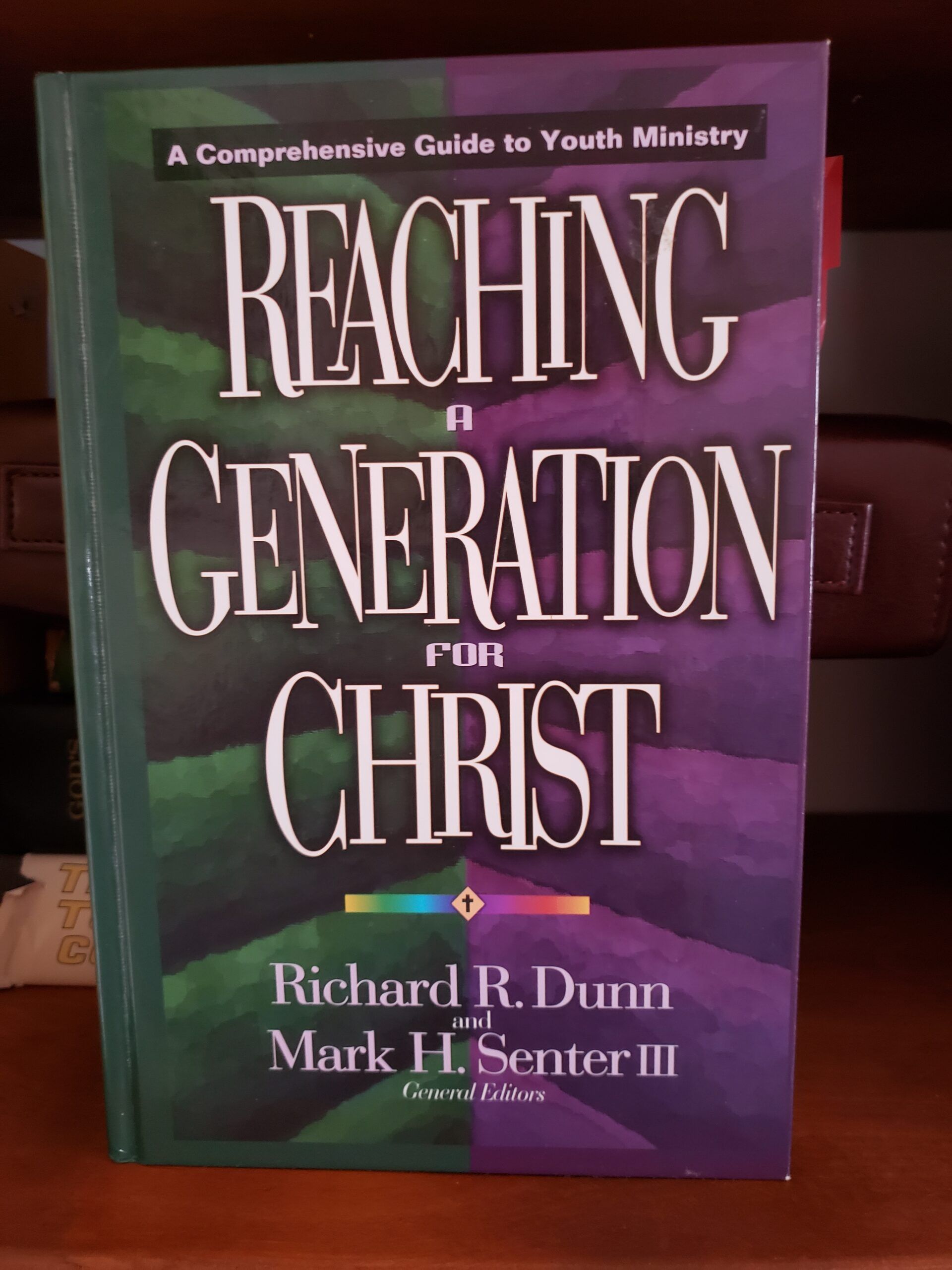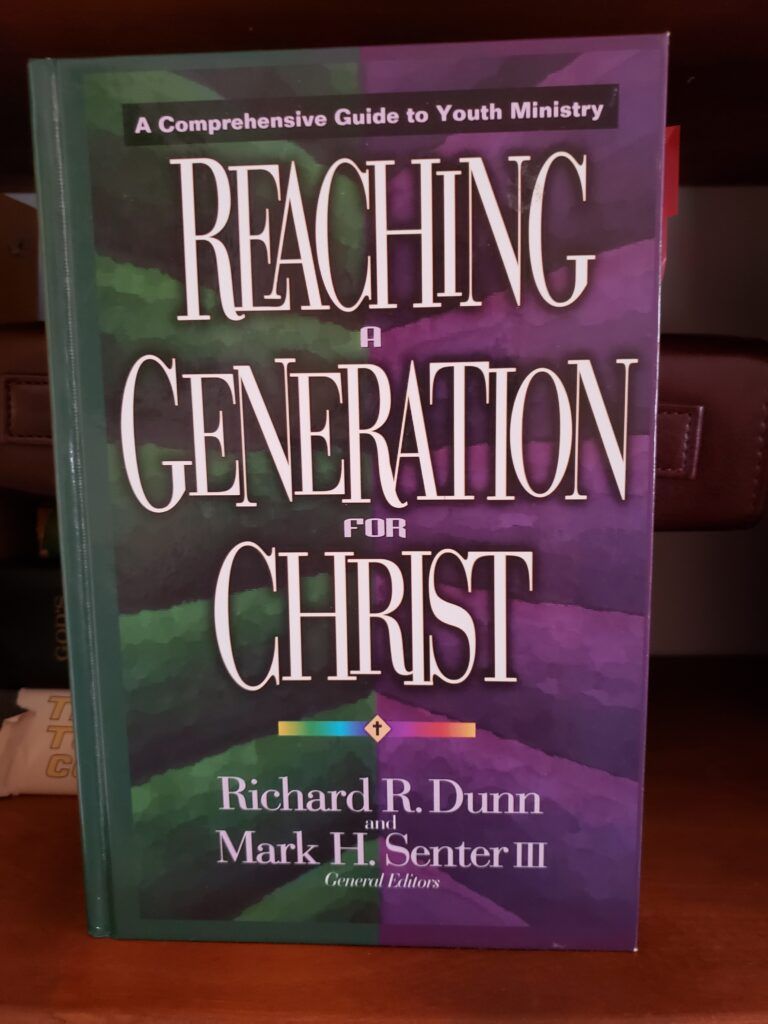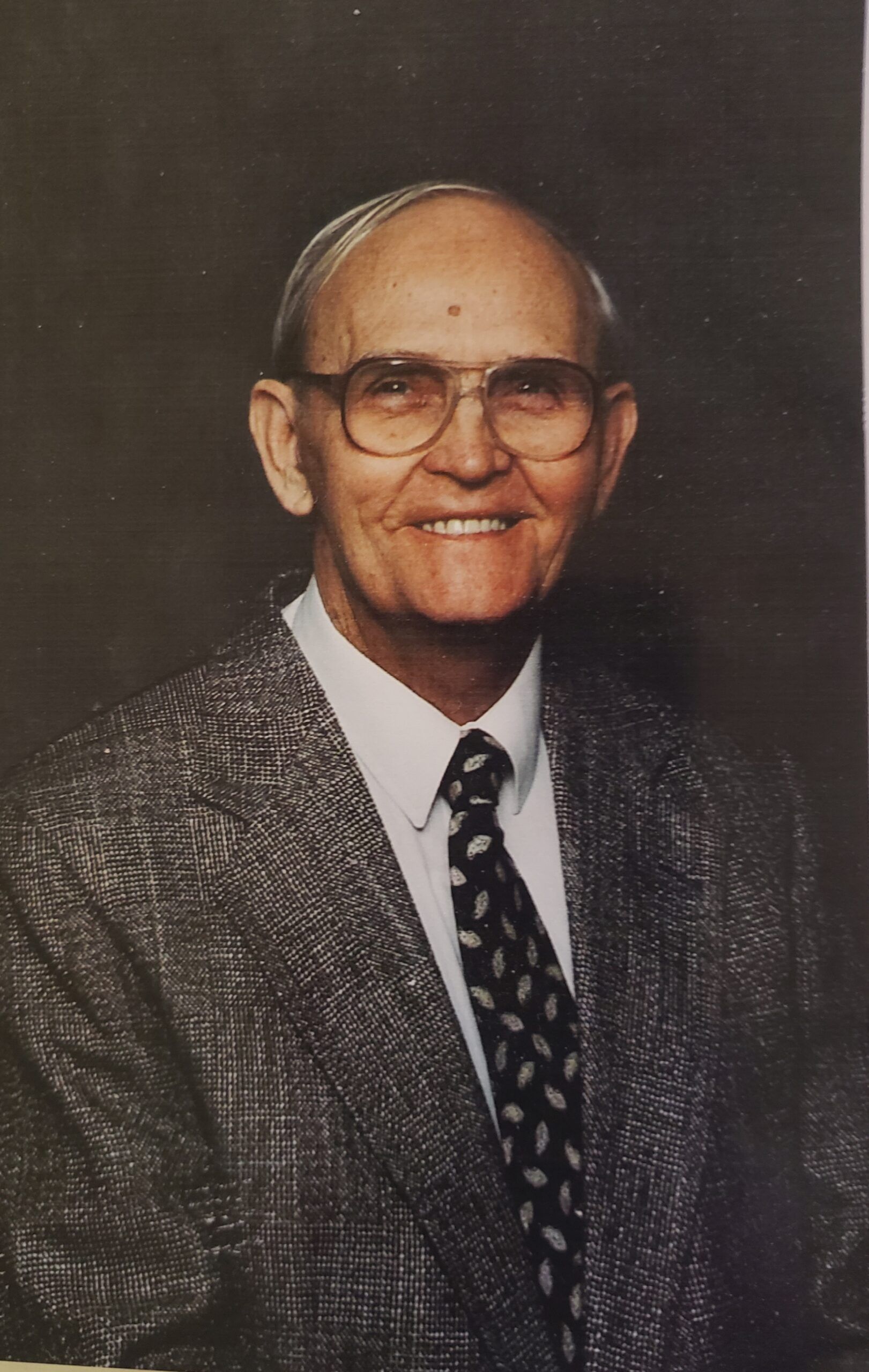

As I indicated in the introductory article to this new series, “Reaching a Generation for Christ,” I am planning to publish a new article the 4th Saturday of every month. As I struggled with the content for this series, I did not make my own deadline and missed the October issue. The series will be loosely based upon the book of the same title, edited by Richard R. Dunn and Mark H. Senter III and published and copyrighted in 1997 by Moody Press. We will examine some of the thoughts and ideas presented in this book, compare them with Scripture and try to draw some applications. The articles will be written primarily by me, with perhaps a guest article periodically. I would appreciate your comments and feedback on the articles, and if you think they contain beneficial content, please share the posts with others.
Richard R. Dunn begins the first chapter in the book with a story describing the experience of Steve, the first youth pastor at Easton Community Church which is also Steve’s first assignment. “In the candidating process Steve had felt quite confident of his readiness for youth ministry. Now, on the occasion of his first day as a youth pastor, several questions are beginning to threaten that self-assurance. These questions include: How can I ever meet the needs of students from such diverse and social backgrounds? How can I build maturity into the lives of the twenty junior high and fifteen high school students who attend youth Sunday school? How can I build bridges to the other five thousand students who attend schools within five miles of the church? What changes should I be making right away?” (p. 26).
Mr. Dunn says that everyone in youth ministry has a perspective that is “based upon their past church, ministry, educational, and personal spiritual experiences” and that they have a “preconceived set of ideas about what is important in terms of values and practices in youth ministry.” He also suggests that, because no one has perfect 20/20 vision, as it relates to youth ministry, there is the opportunity to bring that perspective into clearer focus. He further suggests a process through which this refocusing can be accomplished, that includes the following three frameworks:
Theological Framework: A “God-View”
Dunn describes this framework as one’s understanding of “the way God sees.” He says, “Based upon biblical knowledge and theological reasoning each person has a perception of who God is and how He views the created world, including people and relationships” (p. 29). He then describes six benefits of this framework:
1. “It provides the basic rationale for youth ministry….
2. “It guides the ministry Godward….
3. “It guides the ministry into the faith community….
4. “It critiques ministry practices….
5. “It determines the context and shapes the delivery of the teaching….
6. “It provides ministry motivation and challenge for service….” (pp. 29-33)
Developmental Framework: A “Youth-View”
The second framework, Dunn labels developmental and defines as one’s “understanding of the way the world is experienced in the life stage of adolescence: ‘the way youth see.” He says, “’How do students experience and make sense of their world?’ is the central question to be answered” (p. 34). He then describes four reasons that this framework is important:
1. “It overcomes inaccurate stereotypes….
2. “It informs theological understanding of spiritual maturity….
3. “It provides tangible “touch points” for intangible spiritual ministry….
4. “It shapes the discernment of outcomes and process of assessment….” (pp. 36-38)
Sociological Framework: An “Inside-View”
The third framework, Dunn labels sociological and defines as how the teenager’s environment shapes their perspective into a worldview. He says, “The socio-cultural framework is formed by the youth leader’s understanding of (a) the student’s views of social roles, networks, groups, and interpersonal affiliations and (b) the student’s relationship to cultural symbols, myths, rituals, belief systems, and worldviews” (p. 39). He then describes six reasons that this framework is important:
1. “It bridges generational assumptions….
2. “It bridges cultural assumptions….
3. “It informs a holistic understanding of an individual’s personal and spiritual development….
4. “It provides a framework for exegeting behavior….
5. “It critiques the relevance of practices for a moment in time….
6. “It identifies, in concert with the developmental lens, tangible “touch points” for incarnational ministry among youth….” (pp. 40-43)
After presenting these frameworks, Dunn draws some conclusions, which I have summarized with the following four quotes:
1. “Developing one’s ministry perspective is a long-term process of focusing theological, developmental, and sociological lenses (see Getz 1988 for a similar development).”
2. A youth minister assignment will serve as “a catalyst for intentionally broadening and sharpening his particular understanding of the nature and practice of youth ministry.”
3. “Ultimately, it will be his daily commitment to listen to students, to seek wisdom in God’s Word, to pray with and for the students, to reflect upon successes and failures, and to submit to the guidance of the Holy Spirit that will help him form an increasingly mature ministry perspective.”
4. “Steve came to Easton to make a difference by ministering the gospel to students in the community. Little did he know that the ministry of the gospel in that community would make such a difference in him.”
How Does the Teaching of This Chapter Compare with Scripture?
I am afraid that many who believe strongly in “youth ministry” will not appreciate what I am about to say, but say it I must. As you study the subject of Bible Authority, you understand that there are three ways to establish the truth on any topic. Those three ways are: 1) direct command, 2) approved apostolic example, and 3) necessary inference. As you apply those to “youth ministry,” you find no authority for a separate program labeled such to exist within the local church. Now, if you want to form an organization separate from the church that seeks to guide young people, that is perfectly fine. I have personally been associated with various works of this kind.
Florida College in Temple Terrace, FL operates the Florida College Summer Camp program with camps scattered throughout the country. I have been a counselor at one of those camps. Those camps endeavor “to provide future generations with a glimpse of the Florida College experience, full of opportunities to grow spiritually, make memories and build lifelong relationships. With more than 20 camps across the country, volunteers with a passion for the mission of Florida College make it their aim to provide what many campers call the best week of the year” (https://www.floridacollege.edu/about-fc/summer-camps/).
Another program that I have personal experience with is The Heart of a Champion Character Development Program. The stated mission of that organization is “to transform culture by providing the necessary resources to educate, motivate and empower students, teachers, families and groups in core principles essential to lifetime personal development and maximized performance.” This program is conducted within the framework of a High School or Junior High School. In describing the program’s approach, they say, “Heart of a Champion teaches students about character using a program that consistently reinforces positive character traits by giving examples of persons with high character. These stories are told through quality print and video stories that engage all students. Our program focuses on nine core character traits – Commitment, Leadership, Perseverance, Teamwork, Respect, Integrity, Responsibility, Self-Control and Compassion. Each month students learn about a different trait that is broken down into four weekly lessons. Each lesson involves one video story, one print story, one group activity, and group discussion questions” (https://www.heartofachampion.org/aboutus.html).
A third program that I have personal experience with is YouthFriends. I served as a mentor to two young men while living in the Kansas City area. Youth Friends described its work, “YouthFriends volunteers are caring adult role models from the community who volunteer with young people in schools, grades K-12. The goal is to help students achieve success, both academically and socially. A child is matched up with a YouthFriends Mentor through his/her school district. YouthFriends will meet for one hour, once a week, either one-on-one or in a small group.” I was saddened to learn, as I prepared this article, that YouthFriends shut down on May 31, 2013. An article by Joe Robertson that appeared in the April 10, 2013 Kansas City Star, described their difficulties, “After 18 years and some 300,000 students served, YouthFriends is calling it quits. The nonprofit agency recruited and screened thousands of adult volunteers for more than two dozen area school districts, sending them into lunchrooms and classrooms to spend time one-to-one mentoring a youth friend. But signs of financial strain had been mounting, as the agency this year required participating school districts to begin bearing some of the program’s costs. This week, the agency notified the districts that the service would end by May 31” (https://www.kansascity.com/news/local/article317512/YouthFriends-school-volunteer-program-shutting-down.html).
Kert Wetzig gives a good history of the development of youth ministry in his 3 part series titled “A PERSPECTIVE FOR YOUTH MINISTRY” at http://www.gracebiblestudies.org/resources/web/www.duluthbible.org/g_f_j/2000GFJ.htm. But a significant note is this statement in part 1, “It is interesting to note that there is no historical precedence for youth ministry. As you read through the annals of church history, you do not find any mention of youth ministries or programs before the nineteenth century (but then again, you also do not find Sunday schools, nurseries, ushers, etc.). There is virtually no mention of the role of children or teens in the church.2
2 In some instances it appears young children were discouraged from attending church at all. Elmer T. Clark, in his book The Small Sects in America (New York: Abingdon Press, 1949), pp. 202-203, tells of a written attack directed towards a man who insisted on taking his children to their rural Baptist church in the 1880’s. The letter said, “I do not object to seeing young people to meeting providing they behave themselves; and of course, it is especially encouraging if they seem to have an interest in gospel truth; but Mr. Gold goes farther than this, seeming to hold it as a sacred duty for Old School Baptists to take their children; even their babies to their meeting and see that they ‘give what attention they can to the preaching.'”
Is Youth Ministry Killing the Church?
Interestingly enough that is the title of a recent article that appeared in The Christian Century (https://www.christiancentury.org/blogs/archive/2010-02/youth-ministry-killing-church). Kate Murphy in the February 4, 2010 article says, “Kenda Creasy Dean and others warn that when our children and youth ministries ghettoize young people, we run the risk of losing them after high school graduation. I saw evidence of this in Jonathan. Over the years I’ve worked with young people as passionate and serious about their faith as Jonathan is. I think I’ve done youth ministry with integrity. But I may have been unintentionally disconnecting kids from the larger body of Christ. The young people at my current congregation—a church that many families would never join because “it doesn’t have anything for youth”—are far more likely to remain connected to the faith and become active church members as adults, because that’s what they already are and always have been.”
Another article, written in 2013, “Christian Teens Abandon Faith Because of Youth Groups, Not Despite Them,” says, “According to a new 5-week, 3-question national survey sponsored by the National Center for Family-Integrated Churches (NCFIC), the youth group itself is the problem. 55% of American Christians are concerned with modern youth ministry because it’s too shallow, too entertainment focused, resulting in an inability to train mature believers. But, even if church youth groups had the gravitas of Dallas Theological Seminary, 36% of today’s believers are convinced that youth groups themselves are not even Biblical. (https://churchexecutive.com/archives/christian-teens-abandon-faith-because-of-youth-groups-not-despite-them)
A more recent article written November 20, 2017, “The Flawed History of Youth Ministry in Less than 400 Words,” says, “Scholars have dedicated much ink to youth ministry’s problems in its initial generation. In particular, the field has drawn much criticism for its failure to form students with lasting faith. Some surveys estimate that as many as seventy-percent of young people left the church after high school (Lifeway, 2006). However, youth ministry has learned a great deal in the last decade, and continues to move forward.” According to author Cameron Cole, there are 3 problems that plagued youth ministry in the past: (1) Youth ministry had the wrong purpose, (2) Youth ministry used the wrong provisions, (3) Youth ministry operated in the wrong place. He claims that if these problems are fixed that youth ministry can be effective.
So What Is the Application We Need to Make?
I concur wholeheartedly with the answer given by the website GotQuestions.org to the question “What does the Bible say about youth ministry?” Since I already cited this article last month, I will only copy the first paragraph of the article here.
“Although youth ministry is a fixture in the modern church, there is no biblical model for such a ministry. However, biblical principles can and should be the model for all ministries in the local church, including ministry to youth. Sadly, too many youth ministries are built not on biblical principles but on fads, hype, and shallow youth culture. For this reason, many are asking the question: Is youth ministry even something God wants the church involved in? If the church wants to follow the model of fads, hype, and shallow youth culture, then the answer is a resounding no! However, student ministry, at its core, should be evaluated on the same biblical basis as any other functioning ministry in the local church…. (https://www.gotquestions.org/youth-ministry.html).
So the application of the principles in Reaching A Generation For Christ by Richard R. Dunn and Mark H. Senter III are fine for organizations like the three mentioned above, but their application to our work with the young people within our local churches is not appropriate. The Bible is to be our standard of authority in those instances. In future articles in this series, then, I will reflect upon and note my observations as how they might relate to Florida College Summer Camps, Heart of a Champion Character Development Program, and other similar youth-oriented programs.
Thanks for reading …
–Randy



